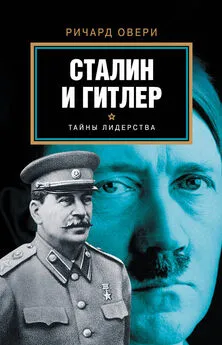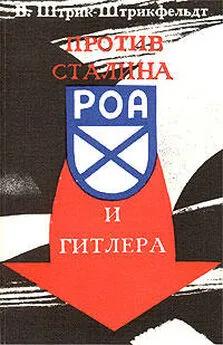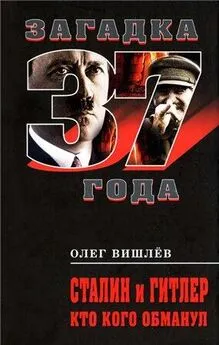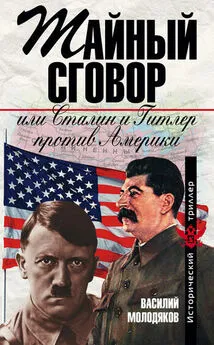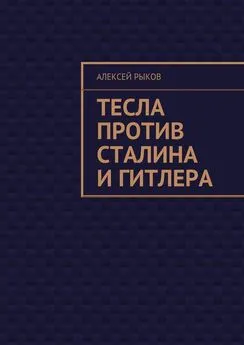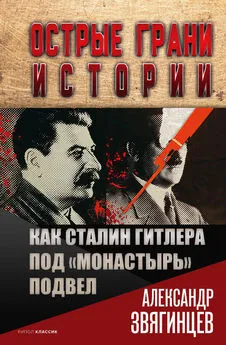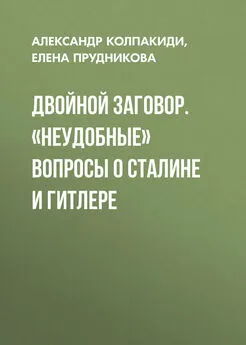Ричард Овери - Сталин и Гитлер
- Название:Сталин и Гитлер
- Автор:
- Жанр:
- Издательство:АСТ
- Год:2015
- Город:Москва
- ISBN:978-5-17-082961-3
- Рейтинг:
- Избранное:Добавить в избранное
-
Отзывы:
-
Ваша оценка:
Ричард Овери - Сталин и Гитлер краткое содержание
Что это были за личности?
Какими были методы их правления?
В чем мораль диктатуры как таковой и к чему она ведет?
На эти и другие наболевшие вопросы отвечает известный британский историк, автор крупных работ по истории Второй мировой войны Ричард Овери.
При сравнение и сопоставление двух режимов Овери рассматривает степень и характер народной поддержки, очаги противостояния и сопротивления, путь к власти каждого из диктаторов и процесс формирования культа личности и т. д.
Сталин и Гитлер - читать онлайн бесплатно полную версию (весь текст целиком)
Интервал:
Закладка:
18. Rigby, Communist Party Membership, pp. 275–80.
19. D. Orlow The History of the Nazi Party: Volume II 1933–1945 (Newton Abbot, 1973), pp. 55–6, 202.
20. Kater, The Nazi Party, p. 263; Orlow, Nazi Party: II, pp. 203–5, 253, 323.
21. Rigby, Communist Party Membership, p. 73; D. Schmiechen-Ackermann ‘Der “Blockwart”’, Vierteljahrshefte für Zeitgeschichte,
48 (2000), pp. 584–5.
22. Rigby, Communist Party Membership, pp. 204–13; Fainsod, How Russia is Ruled, 260–61, 262; see too J. A. Getty The Origin of the Great Purges: The Soviet Communist Party Reconsidered 1933–1938 (Cambridge, 1985).
23. Fainsod, How Russia is Ruled, pp. 177, 196.
24. Rigby, Communist Party Membership, pp. 263–75.
25. Schmiechen-Ackermann, ‘Der “Blockwart”’, pp. 596–7.
26. Calculated from Kater, Nazi Party, p. 263.
27. Orlow, Nazi Party: II, pp. 124–5.
28. Schmiechen-Ackermann, ‘Der “Blockwart’”, p. 587.
29. D. Mühlberger The Pattern of the SA’s Social Appeal’, in C. Fisher (ed.) The Rise of National Socialism and the Working Classes in Weimar Germany (Oxford, 1996), pp. 99–116.
30. A. Graziosi A New, Peculiar State: Explorations in Soviet History 1917–1937 (Westport, Conn., 2000), pp. 196–7.
31. Fainsod, How Russia is Ruled, p. 251; R. Hill and P. Frank The Soviet Communist Party (London, 1983), pp. 33–6.
32. K. Boterbloem Life and Death under Stalin: Kalinin Province, 1945–1953 (Montreal, 1999), p. 102; Fainsod, How Russia is Ruled, p. 264.
33. C.-C. Szejnmann Vom Traum zum Alptraum: Sachsen in der Weimarer Republik (Dresden, 2000), pp. 114–16.
34. Kater, The Nazi Party, pp. 264–7; D. Miihlberger (ed.) The Social Basis of European Fascist Movements (London, 1987), pp.
76–94: C. Roth Parteikreis und Kreisleiter der NSDAP unter besonderer Berücksichtigung Bayerns (Munich, 1997), p. 182;
H.-U. Thamer Verführung und Gewalt: Deutschland 1933–1945 (Berlin, 1986), p. 175.
35. J. Falter and M. H. Kater ‘Wähler und Mitglieder der NSDAP’, Geschichte und Gesellschaft, 19 (1993), p. 165.
36. Roth, Parteikreis und Kreisleiter, p. 183; Meissner, Communist Party, p. 10.
37. Fainsod, How Russia is Ruled, pp. 254, 271; Rigby, Communist Party Membership, p. 361.
38. Rigby, Communist Party Membership, p. 354; Fainsod, How Russia is Ruled, pp. 257, 274.
39. Roth, Parteikreis und Kreisleiter, p. 180; Thamer, Verführung und Gewalt, p. 178; Kater, The Nazi Party, p. 257.
40. Gill, Rules of the Communist Party, pp. 162–3, Rules of the All-Union Communist Party, 1934.
41. Avtorkhanov, Communist Party Apparatus, pp. 119, 122; Fainsod, How Russia is Ruled, pp. 229–30.
42. Avtorkhanov, Communist Party Apparatus, pp. 153–4; Fainsod, How Russia is Ruled, p. 196; M. Fainsod Smolensk under Soviet Rule (Boston, Mass., 1989), pp. 63, 113; L. Schapiro The Communist Party of the Soviet Union (London, 1960), pp. 444–5.
43. Reibel, Fundament der Diktatur, pp. 32–5.
44. Reibel, Fundament der Diktatur, pp. 121, 123; Schmiechen-Ackermann, ‘Der “Blockwart’”, p. 586.
45. Münz, Führer durch die Behörden und Organisationen, pp. 6–8.
46. Reibel, Fundament der Diktatur, pp. 50–51, 56–63.
47. Fainsod, How Russia is Ruled, pp. 284–91; Avtorkhanov, Communist Party Apparatus, pp. 256–7; see too I. Tirado, ‘The Komsomol and the Bright Socialist Future’, in C. Kuhr-Korolev, S. Plaggenborg and M. Wellmann (eds) Sowjetjugend 1917–
1941; Generation zwischen Revolution und Resignation (Essen, 2001), pp. 217–32.
48. G. Kinz Der Bund Deutscher Mädel: Ein Beitrag zur ausserschulisch en Mädchenerziehung im Nationalsozialismus (Frankfurt am Main, 1990), pp. 3–12, 25; C. Schubert-Weller Hitler-Jugend: Vom ‘Jungsturm Adolf Hitler’ zur Staatsjugend des Dritten Reiches (Weinheim, 1993), pp. 13–15, 33–4.
49. H. Vorländer Die NSV: Darstellung und Dokumentation einer nationalisozialistischen Organisation (Boppard am Rhein, 1988), pp. 1–14, 96; J. Stcphcnson The Nazi Organisation of Women (London, 1981), pp. 50–55, 140.
50. Avtorkhanov, Communist Party Apparatus, p. 13.
51. E. van Ree ‘Stalin’s Organic Theory of the Party’, Russian Review, 52 (1993), p. 54.
52. S. Allan Comrades and Citizens: Soviet People (London, 1938), pp. 88–9, 94–5.
53. Fainsod, How Russia is Ruled, pp. 260–61; Fainsod, Smolensk under Soviet Rule, pp. 220–22.
54. Allan, Comrades and Citizens, pp. 257–9.
55. Fainsod, Smolensk under Soviet Rule, p. 230; S. Pons ‘Stalinism and Party Organisation (1933–1948)’, inj. Channon (ed.) Politics, Society and Stalinism in the USSR (London, 1998), pp. 96–7.
56. D. M. McKale The Nazi Party Courts: Hitler’s management of confl ict in his Movement 1921–1945 (Lawrence, Kans., 1974), pp. 77–8, 123.
57. McKale, Nazi Party Courts, p. 55.
58. McKale, Nazi Party Courts, p. 22–3.
59. McKale, Nazi Party Courts, pp. 144–5, 164, 178–80; M. Moll, ‘Steuerungsinstrument im “Ämterchaos”? Die Tagungen der Reichs-und Gauleiter der NSDAP’, Vierteljahrshefte für Zeitgeschichte, 49 (2001), pp. 236–8.
60. Allan, Comrades and Citizens, p. 88.
61. E. P. Mickiewicz, Soviet Political Schools: the Communist Party Adult Instruction System (New Haven, Conn., 1967), pp. 3–9,
89–101; M. David-Fox Revolution of the Mind: Higher Learning among the Bolsheviks, 1918–1929 (Ithaca, NY, 1997), pp. 84–7; T. Kirstein, ‘Das sowjetische Parteischulsystem’, in B. Meissner, G. Brunner and R. Löwenthal (eds) Einparteisystem und bürokratische Herrschaft in der Sowjetunion (Cologne, 1978), pp. 204–16.
62. Orlow, Nazi Party: II, pp. 188–92; Schmiechen-Ackermann, ‘Der “Blockwart”’, p. 589.
63. Schubert-Weller, Hitler-Jugend, pp. 182–3; on selection and admission see the testimony of P. Peterson in J. Steinhoff, P. Pechel and D. Showalter (eds) Voices of the Third Reich: an Oral History (Washington, DC, 1989), pp. 8–9.
64. Avtorkhanov, Communist Party Apparatus, pp. 79–80; Schmiechen-Ackermann, ‘Der “Blockwart”’, p. 586; M. Voslensky Nomenklatura: Anatomy of the Soviet Ruling Class (London, 1984), pp. 48–9.
65. Allan, Comrades and Citizens, p. 242.
66. Schmiechen-Ackermann, ‘Der “Blockwart”’, p. 589.
67. Gill, Rules of the Communist Party, pp. 165–6.
68. Schmiechen-Ackermann, ‘Der “Blockwart”’, pp. 581–3; Reibel, Fundament der Diktatur, pp. 104–5; Stephenson, Nazi Organisation of Women, p. 155; L. Pine ‘Creating Conformity: the Training of Girls in the Bund Deutscher Mädel’, European History Quarterly, 33 (2003), pp. 367–85.
69. Schmiechen-Ackermann, ‘Der “Blockwart”’, pp. 590–95; J. Noakes (ed.) Nazism 1919–1945: a Documentary Reader: Volume 4 (Exeter, 1998), pp. 96–100, ‘Service Instructions for Block Leaders. 1 June 1944’.
70. Reibel, Fundament der Diktatur, pp. 104–5, 191.
71. D. Rebentisch ‘Die “politische Beurteilung” als Herrschaftsinstrument der NSDAP’, in D. Peukert and J. Reulecke (eds) Die Reihen fast geschlossen: Beiträge zur Geschichte des Alltags unterm Nationalsozialismus (Wuppertal, 1981), pp. 107–28; Roth, Parteikreis und Kreisleiter, pp. 269–70.
72. Rebentisch, ‘Die “politische Beurteilung” ‘, p. 114.
73. Rebentisch, ‘Die “politische Beurteilung”’, pp. 108, 117–18.
74. Roth, Parteikreis und Kreisleiter, pp. 282–3.
75. S. Labin, Stalin’s Russia (London, 1949), p. 149; Tirado, The Komsomol’, pp. 220–22.
76. Labin, Stalin’s Russia, p. 153.
77. Boterbloem, Life and Death under Stalin, p. 125.
78. A. Smith I Was a Soviet Worker (London, 1937), p. 242.
79. Noakes, Nazism: Volume 4, pp. 97–8.
80. Vorländer, Die NSV: Dokumente, pp. 53–4.
81. G. Miller-Kipp (ed.) ‘Auch Du gehörst dem Führer’: Die Geschichte des Bundes Deutscher Mädel in Quellen und Dokumenten (Munich, 2001), p. 62.
82. See for example C. Arbogast Herrschaftsinstanzen der württembergischen NSDAP: Funktion, Sozialprofi l und Lebenswege einer regionalen NS-Elite 1920–1960 (Munich, 1998), pp. 116–22.
83. On the development of German bureaucracy J. Caplan ‘Profession as Vocation: The German Civil Service’, in G. Cocks and K. Jarausch (eds) German Professions, 1800–1950 (Oxford, 1990), pp. 163–82.
84. T. H. Rigby ‘Staffi ng USSR Incorporated: The Origins of the Nomenklatura System’, Soviet Studies, 40 (1988), pp. 526–30.
85. Labin, Stalin’s Russia, p. 50; Rigby, ‘Staffi ng USSR Incorporated’, pp. 531–3.
86. Labin, Stalin’s Russia, p. 50.
87. R. Koshar Social Life, Local Politics, and Nazism: Marburg 1880–1935 (Chapel Hill, NC, 1986), pp. 247–50.
88. J. H. Grill The Nazi Movement in Baden 1920–1945 (Chapel Hill, NC, 1983), pp. 247–8, 257, 265.
89. H. Fenske Bürokratie in Deutschland von späten Kaiserreich bis zur Gegenwart (Berlin, 1985), pp. 40–43.
90. Fenske, Bürokratie in Deutschland, pp. 44, 48; M. Broszat The Hitler State: the foundation and development of the internal structure of the Third Reich (London, 1981), pp. 242–3.
91. Orlow, Nazi Party: II, pp. 226–7; H. Mommsen Beamtentum in Dritten Reich: mit ausgewählten Quellen zur nationalsozialistischen Beamtenpolitik (Stuttgart, 1966), pp. 103–4.
92. Roth, Parteikreis und Kreisleiter, pp. 234–5.
93. Roth, Parteikreis und Kreisleiter, p. 195.
94. Roth, Parteikreis und Kreisleiter, pp. 213, 215.
95. Orlow, Nazi Party: II, pp. 228–9.
96. Schmiechen-Ackermann, ‘Der “Blockwart”’, p. 586; Orlow, Nazi Party: II, pp. 72–3.
97. Avtorkhanov, Communist Party Apparatus, pp. 143, 199.
98. Münz, Führer durch die Behörden, pp. 6–9.
99. Roth, Parteikreis und Kreisleiter, pp. 122–3.
100. Roth, Parteikreis und Kreisleiter, pp. 139–44.
101. Broszat, Hitler State, pp. 112–17; on the Reichsstatthalter see H.-J. Sengotta Der Reichsstatthalter in Lippe 1933 bis 1939.
Reichsrechtliche Bestimmungen und politische Praxis (Detmold, 1976), pp. 41–59, 408–9.
102. Moll, ‘Steuerungsinstrument’, pp. 215–72; more generally on the Gauleiter see P. Hiittenberger Die Gauleiter (Stuttgart, 1969).
103. Fainsod, How Russia is Ruled, p. 199.
104. Fainsod, Smolensk under Soviet Rule, p. 98.
105. Mommsen, Beamtentum, p. 103.
106. Gill, Rules of the Communist Party, pp. 44–7.
107. Avtorkhanov, Communist Party Apparatus, pp. 103–4; Pons, ‘Stalinism and Party Organisation’, pp. 108–9.
108. B. Harasymiw Soviet Communist Party Offi cials: A study in organizational roles and change (New York, 1996), pp. 85–8.
109. B. Meissner ‘Die besonderen Wesenszüge der sowjetschen Bürokratie und die Wandlungsmöglichkeiten des Einparteisystems’ in Meissner, Brunner and Löwenthal, Einparteisystem, pp. 73–4; R. di Leo Occupazione e salari neWURSS 1950–1977 (Milan, 1980), pp. 38–9, 50.
110. Harasymiw, Communist Party Offi cials, p. 30.
111. Fenske, Bürokratie in Deutschland, pp. 45–7.
112. Fenske, Bürokratie in Deutschland, pp. 48–51.
113. See R. Koehl The Black Corps: the Structure and Power Struggles of the Nazi SS (Madison, Wise, 1983); the process of infi ltration and control is charted in A. Speer The Slave State: Heinrich Himmlers Masterplan for SS Supremacy (London, 1981).
114. Meissner, ‘Der besonderen Wesenzüge’, p. 77.
115. Fenske, Bürokratie in Deutschland, p. 45.
116. The party revived after Stalin’s death. See Y. Gorlizki ‘Party Revivalism and the Death of Stalin’, Slavic Review, 54 (1995), pp. 1–22.
Читать дальшеИнтервал:
Закладка:
